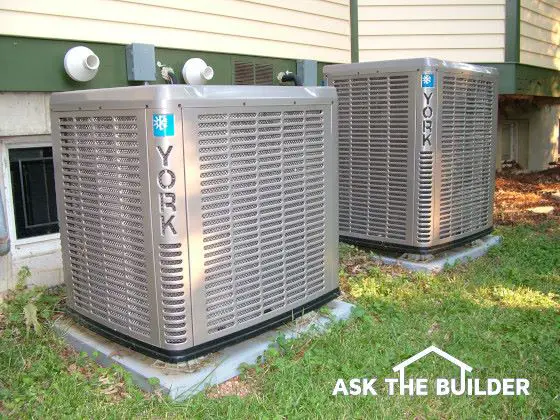Air Conditioning Sizing Problems

These are two AC units outside my own home. I have two separate systems in my home, one for the first floor and one for the second floor. Copyright 2018 Tim Carter
DEAR TIM: I have never been satisfied with the performance of our central air conditioner. Even though the unit runs 45 minutes or more each hour, the house never seems really cool. All of the rooms that face west become unbearably hot in the late afternoon. A neighbor's house across the street has an identical floor plan and their house seems very comfortable. Periodic checks of our system indicate that the refrigerant level is fine. Why am I so hot? Ron W., San Marcos, TX
DEAR RON: Your discomfort can be caused by any number of problems. However, I suspect that a mistake was made when you house was built. It is a distinct possibility that the outdoor air conditioner and the coil inside your air handler or furnace is too small.
I think that the cooling contractor either made an error in his sizing calculations or simply guessed at the size air conditioner needed to cool you home. Air conditioners are like shoes. Ones that don't fit are simply uncomfortable!
All houses attract and create heat. The infrared energy contained in natural sunlight is the heat energy that comes through windows, doors, air leaks, and through insulated walls and ceilings. Appliances, light fixtures, even our own bodies create heat within houses.
All of this heat can be easily measured. Air conditioning contractors and manufacturers refer to the accumulated heat as heat gain. It is measured in British Thermal Units (Btus).
Air conditioning equipment comes in different sizes. The cooling capacity of a particular system is measured in tons. One ton of cooling equals 12,000 Btus or the amount of heat it takes to melt one ton of ice in a 24 hour period. Typical residential air conditioners can be purchased in sizes that range from 1 ton to 7 tons often in one-half ton increments.
My guess is that you and your neighbor have the same sized air conditioners. Their house is comfortable because they have much less glass surface pointing west. West or southwest facing glass allows enormous amounts of heat into your home. This explains why your west facing rooms are so hot.
Air conditioning engineers have developed straight forward step-by-step procedures that allow just about anyone to calculate with considerable accuracy just how much heat accumulates in their house.
To calculate your house's heat gain, you simply need a measuring tape, notepad and pencil, a simple calculator, a compass, cooling load calculation tables, and several hours of your free time.
You first need to obtain a copy of the cooling load calculation tables. Cooling contractors and those in the industry commonly refer to this publication as Manual J. The tables are published by the Air Conditioning Contractors of America.
You may be able to find a copy of Manual J at your local library or from an air conditioning contractor of distributor in your city. The booklet looks intimidating but if you can follow step by step instructions, you can do the calculations quickly and accurately. If your final total of Btus is in the tens of thousands (20,000 - 55,000 or more Btus), then you have done well!
Once you have completed your calculations and checked your math for accuracy, you need to look at your outdoor air conditioning unit. Often you will readily see a plate that contains a model number, serial number and other numbers.
The tonnage capacity of your unit is contained within the numbers on this plate. Your air conditioning service person can quickly tell you how many tons of cooling your air conditioner will produce after reviewing these numbers. Divide your final total Btus by 12,000 and see if the two numbers match!
Column 231